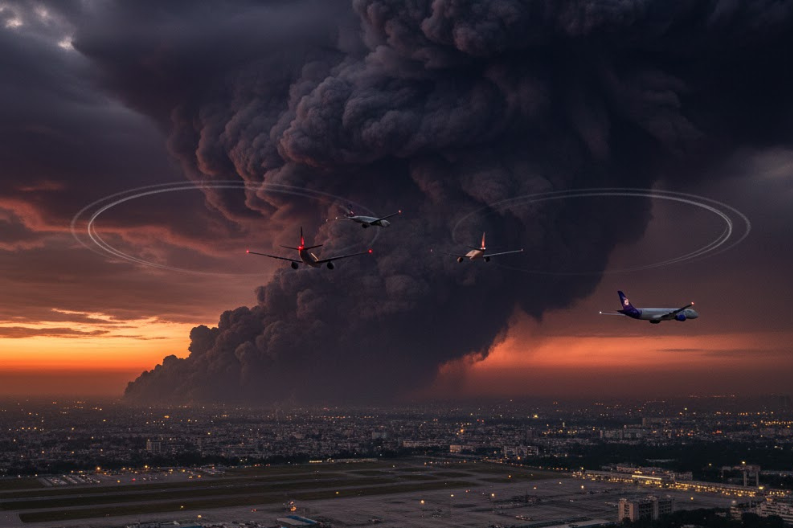An Ethiopian volcano eruption sends ash to Delhi after the long-dormant Hayli Gubbi volcano awakened on Sunday morning, November 23, 2025. The volcano, which had remained quiet for nearly 12,000 years, sent a massive ash column thousands of feet into the atmosphere. Subsequently, the ash cloud traveled across the Red Sea, passing through Yemen and Oman before reaching the Indian capital.
The Hayli Gubbi volcano sits in Ethiopia’s Afar region, approximately 800 kilometers northeast of Addis Ababa near the Eritrean border. Importantly, this area lies within the Rift Valley, where two tectonic plates meet, creating intense geological activity. Moreover, experts believe tectonic movements in the region triggered this historic eruption.
According to the Smithsonian Institution’s Global Volcanism Program, this marks the first recorded eruption during the Holocene period. Furthermore, Simon Carn, a volcanologist at Michigan Technological University, confirmed that the volcano has no known record of eruptions in recorded history.
The eruption began on Sunday and continued for several hours. Consequently, thick ash plumes rose up to 14 kilometers high into the sky. Additionally, local residents reported hearing loud explosions and feeling shockwaves from the eruption.
Ahmed Abdela, a resident of the Afar region, described the experience: “It felt like a sudden bomb had been thrown with smoke and ash.” Meanwhile, Mohammed Seid, an Afar regional official, confirmed that while no people or livestock died, many villages became covered in ash. Therefore, animals in affected areas have little to eat.
The ash cloud then began its eastward journey across international borders. Initially, it swept over the Red Sea toward Yemen and Oman. Subsequently, high-level winds carried it across the Arabian Sea toward western and northern India. Eventually, the plume reached Delhi around 11 pm on Monday night, November 24.
India’s aviation authorities quickly responded to the developing situation. Specifically, the Directorate General of Civil Aviation (DGCA) issued a detailed advisory on Monday. Furthermore, the DGCA asked airlines to strictly avoid published volcanic ash-affected areas and flight levels.
Mrutyunjay Mohapatra, director general of India Meteorological Department (IMD), explained the situation to the BBC. He noted that the affected altitude ranges between 8.5 kilometers and 15 kilometers above sea level. Additionally, he said the ash would temporarily affect satellite functions and flight operations.
However, Mohapatra reassured the public that the ash is unlikely to affect weather conditions or air quality. Indeed, the ash plume exists only in the upper troposphere. Therefore, it has no impact near the surface where people live and breathe.
Nevertheless, the ash cloud significantly disrupted flight operations across India. Air India canceled at least 11 flights, both domestic and international, mostly over North India. Specifically, the airline canceled flights from Newark, New York, Dubai, Doha, and Dammam on November 24. Similarly, it canceled several domestic flights on November 25.
Moreover, Akasa Air canceled all flights to and from Jeddah, Kuwait, and Abu Dhabi scheduled for November 24 and 25. Additionally, IndiGo diverted a Kannur-Abu Dhabi flight to Ahmedabad on Monday night. Furthermore, KLM canceled a flight from Amsterdam to Delhi due to the volcanic ash plume.
Mumbai Airport issued an advisory urging passengers to check flight status before leaving for the airport. Similarly, airports across Jaipur, Gujarat, and Rajasthan warned passengers to expect delays and cancellations.
The DGCA directive instructed flight operators to immediately report any suspected ash encounter. Additionally, pilots must report engine performance anomalies or cabin smoke or odor. Furthermore, carriers must inspect aircraft operating near affected zones.
Volcanic ash poses serious risks to aviation. The tiny, abrasive particles can damage aircraft engines, contaminate airfields, and reduce visibility. Therefore, making it hazardous to flight operations.
GP Sharma, president of meteorology and climate change at Skymet Weather, explained the challenges. He noted that measuring contamination from volcanic eruptions requires advance preparation and sensor deployment. However, this particular eruption provided no room for preparation. Consequently, the exact level of contamination remains unknown.
There are three levels of volcanic ash contamination: low, medium, and high. Each level has guidance on how long pilots can fly before causing significant engine damage. However, experts have not yet determined the contamination level in this instance.
The IMD predicted that the ash would continue its eastward movement. Furthermore, officials estimated that Delhi’s skies would clear by 7:30 pm on Tuesday evening. Additionally, Mohapatra told news agency ANI that the volcanic ash would completely move toward China by evening.
Volcanic ash clouds are relatively rare but can cause massive disruption. Notably, when Iceland’s Eyjafjallajökull volcano erupted in 2010, it caused global travel chaos. Indeed, UK and European airspace shut down, leading to the worst air-travel disruption since World War Two.
The Ethiopian volcano eruption sends ash to Delhi, creating temporary flight disruptions while reminding the world of nature’s unpredictable power and the interconnected nature of our global atmospheric systems.



